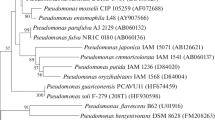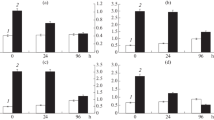Summary
The phenol-degrading strain Pseudomonas putida EKII was isolated from a soil enrichment culture and utilized phenol up to 10.6 mM (1.0 g·1 -1) as the sole source of carbon and energy. Furthermore, cresols, chlorophenols, 3,4-dimethylphenol, and 4-chloro-m-cresol were metabolized as sole substrates by phenol-grown resting cells of strain EKII. Under conditions of cell growth, degradation of these xenobiotics was achieved only in co-metabolism with phenol. Phenol hydroxylase activity was detectable in whole cells but not in cell-free extracts. The specificity of the hydroxylating enzyme was found during transformation of cresols and chlorophenols: ortho- and meta-substituted phenols were degraded via 3-substituted catechols, while degradation of para-substituted phenols proceeded via 4-substituted catechols. In cell-free extracts of phenol-grown cells a high level of catechol 2,3-dioxygenase as well as smaller amounts of 2-hydroxymuconic semialdehyde hydrolyase and catechol 1,2-dioxygenase were detected. The ring-cleaving enzymes were characterized after partial purification by DEAE-cellulose chromatography.
Similar content being viewed by others
References
Bayly RC, Dagley S (1969) Oxoenic acids as metabolites in the bacterial degradation of catechols. Biochem 111:303–307
Bayly RC, Wigmore GJ (1973) Metabolism of phenol and cresols by mutants of Pseudomonas putida. J Bacteriol 113:1112–1120
Bayly RC, Dagley S, Gibson DT (1966) The metabolism of cresols by species of Pseudomonas putida. J Bacteriol 101:293–301
Beadle CA, Smith ARW (1982) The purification and properties of 2,4-dichlorophenol hydroxylase from a strain of Acinetobacter species. Eur J Biochem 123:323–332
Bettmann H, Rehm HJ (1984) Degradation of phenol by polymer entrapped microorganism. Appl Microbiol Biotechnol 20:285–290
Bradford MM (1976) A rapid and sensitive method for the quantitation of microgram quantities of protein utilizing the principle of protein-dye binding. Anal Biochem 72:248–254
Buswell JA (1975) Metabolism of phenol and cresols by Bacillus stearothermophilus. J Bacteriol 124:1077–1083
Chen C-Y, Skidmore DR (1987) Langmuir adsoprtion isotherm for Sulfolobus acidocaldarius on coal particles. Biotechnol Lett 9:191–194
Crawford RL (1975) Novel pathway in the degradation of protocatechuic acid in Bacillus species. J Bacteriol 121:531–536
Ditzelmüller G, Loidl M, Streichsbier F (1989) Isolation and characterization of a 2,4-dichlorophenoxyacetic acid-degrading soil bacterium. Appl Microbiol Biotechnol 31:93–96
Dorn E, Knackmuss H-J (1978) Chemical structure and biodegradability of halogenated aromatic compounds: substituent effects on 1,2-dioxygenation of catechol. Biochem J 174:85–94
Ehrhardt HM, Rehm H-J (1989) Semicontinuous and continuous degradation of phenol by Pseudomonas putida P8 adsorbed on activated carbon. Appl Microbiol Biotechnol 30:312–317
Engelhardt G, Rast HG, Wallnöfer PR (1979) Cometabolism of phenol and substituted phenols by Nocardia spec. DSM 43251. FEMS Microbiol Lett 5:377–383
Feist CF, Hegeman GD (1969) Phenol and benzoate metabolism by Pseudomonas putida: regulation of tangential pathways. J Bacteriol 100:869–877
Gibson DT (1971) Assay of enzymes of aromatic metabolism. Methods Microbiol 6A:463–478
Hashimoto K (1973) Oxidation of phenols by yeast. II. Oxidation of cresols by Candida tropicalis. J Gen Appl Microbiol 16:1–13
Hegeman GD (1966) Synthesis of the enzymes of the mandelate pathway by Pseudomonas putida. I. Synthesis of the enzymes by the wild type. J Bacteriol 91:1140–1154
Hill GA, Robinson CW (1975) substrate inhibition kinetics: phenol degradation by Pseudomonas putida. Biotechnol Bioeng 17:1599–1615
Hughes EJL, Bayly RC, Skurray RA (1984) Evidence for isofunctional enzymes in the degradation of phenol, m-and p-toluate, and p-cresol via catechol meta-cleavage pathways in Alcaligenes eutrophus. J Bacteriol 158:79–83
Li JK, Humphrey AE (1989) Kinetic and fluorometric behaviour of a phenol fermentation. Biotechnol Lett 11:177–182
Loidl M, Hinteregger Ch, Ditzelmüller G, Ferschl A, Streichsbier F (1990) Degradation of aniline and monochlorinated anilines by soil-born Pseudomonas acidovorans strains. Arch Microbiol 155:56–61
Masqué C, Nolla M, Bordons A (1987) Selection and adaptation of a phenol-degrading strain of Pseudomonas. Biotechnol Lett 9:655–660
Nakazawa T, Nakazawa A (1970) Pyrocatechase (Pseudomonas). Methods Enzymol 17A:518–522
Nakazawa T, Yokota T (1973) Benzoate metabolism in Pseudomonas putida (arvilla) mt-2: demonstration of two benzote pathways. J Bacteriol 115:262–267
Neujahr HY, Varga JM (1970) Degradation of phenols by intact cells and cell-free preparations of Trichosporon cutaneum. Eur J Biochem 13:37–44
Nozaki M (1970) Metapyrocatechase (Pseudomonas). Methods Enzymol 17A:522–525
Nozaki M, Kagamiyama H, Hayaishi O (1963) Metapyrocatechase. I. Purification, crystallization and some properties. Biochem Z 338:582–590
Palleroni NJ (1984) Family I: Pseudomonadaceae. In: Krieg NR, Holt JG (eds) Bergey's manual of systematic bacteriology, part 1, 1st edn. Williams and Wilkins, Baltimore, pp 141–290
Pieper DH, Reineke W, Engesser K-H, Knackmuss H-J (1988) Metabolism of 2,4-dichlorophenoxyacetic acid, 4-chloro-2-methylphenoxyacetic acid and 2-methylphenoxyacetic acid by Alcaligenes eutrophus JMP 134. Arch Microbiol 150:95–102
Rubio MA, Engesser K-H, Knackmuss H-J (1986) Microbial metabolism of chlorosalicylates: accelerated evolution by natural genetic exchange. Arch Microbiol 145:116–122
Sala-Trepat JM, Evans WC (1971) The meta-cleavage of catechol by Azotobacter species: 4-oxalocrotonate pathway. Eur J Biochem 20:400–413
Sala-Trepat JM, Murray K, Williams PA (1972) The metabolic divergence in the meta cleavage of catechols by Pseudomonas putida NCIB 10015. Physiological significance and evolutionary implications. Eur J Biochem 28:347–356
Spain JC, Gibson DT (1988) Oxidation of substituted phenols by Pseudomonas putida F1 and Pseudomonas sp. strain JS6. Appl Environ Microbiol 54:1399–1404
Straube G (1987) Phenol hydroxylase from Rhodococcus sp. P1. J Basic Microbiol 27:229–232
Author information
Authors and Affiliations
Rights and permissions
About this article
Cite this article
Hinteregger, C., Leitner, R., Loidl, M. et al. Degradation of phenol and phenolic compounds by Pseudomonas putida EKII. Appl Microbiol Biotechnol 37, 252–259 (1992). https://doi.org/10.1007/BF00178180
Received:
Accepted:
Issue Date:
DOI: https://doi.org/10.1007/BF00178180




